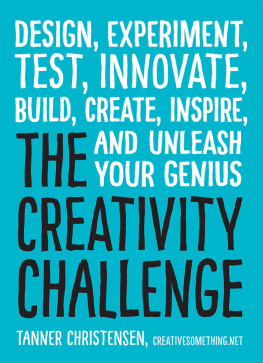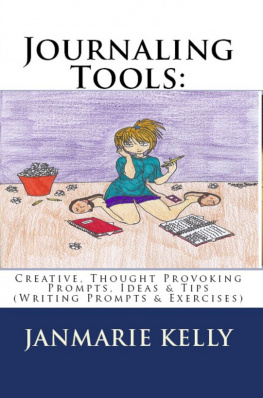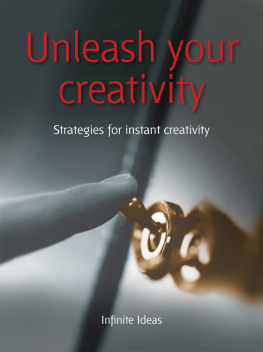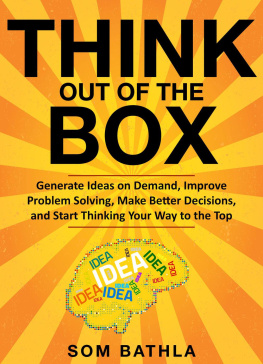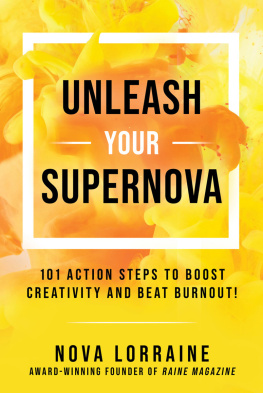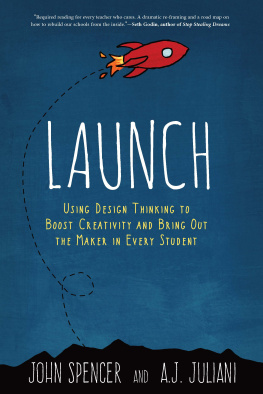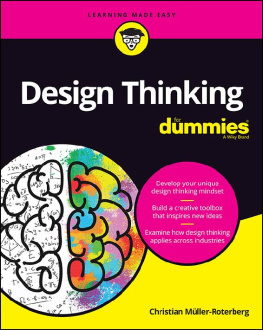THE
CREATIVITY
CHALLENGE
DESIGN, EXPERIMENT, TEST, INNOVATE, BUILD, CREATE, INSPIRE, AND UNLEASH YOUR GENIUS
TANNER CHRISTENSEN, CREATIVESOMETHING.NET

Avon, Massachusetts
Creativity can solve almost any problem. The creative act, the defeat of habit by originality, overcomes everything.
GEORGE LOIS, AMERICAN ART DIRECTOR, DESIGNER, AND AUTHOR
INTRODUCTION
Do you ever find yourself...
- Unable to write that opening paragraph of your presentation?
- Wishing you could take your hobby to the next level?
- Trying to solve a difficult problem, at work or at home?
- Longing to write a book?
No matter what your age, profession, or personal interests, you need creativity in your life. Many of us want to be more creative in our lives and in our work, but its not always easy to generate new and exciting ideas. Thats because the challenge with thinking creatively is that it requires you to change how you think. More than that, creativity requires that you change how you think about thinking.
Is your brain spinning? Dont worry, thats where this book comes in. Heres a secret: You already have immense creative potential in you; you just need some help unleashing it. Within this book, you will find 150 challenges for sparking those valuable insights we so often attribute to creativity, by prompting you to think in new and unique ways.
The creative challenges involve everything from the silly (acting like a three-year-old in order to push your boundaries), to the thoughtful (doodling with strangers in order to overcome biases in your perceptions and gain insights from an outside perspective). Each challenge will push you to rethink how you see the world around you in order to uncover new possibilities and ideas. By completing each challenge, youll have a better foundation for seeing the world in unique ways, and approaching problems you encounter with a more creative light. You can do the challenges alone or with a friend, once a day or all of them at oncethere is no right way to use this book.
Whether you want to be a more imaginative writer, solve problems in your life, overcome boredom, or inspire those around you, youll find the creative spark you need with these exercises! Lets uncover your inner creativity...
HOW TO USE THIS BOOK
Youll quickly find that this book is very easy to use. Whenever you feel stuck or uninspired, simply turn to a random page and follow the instructions to complete the creative challenge you find there. You could read this book in order, front to back (or back to front, if thats your thing), but youre much more likely to gain powerful insights into your thinking by picking a challenge at random. Of course, if you want to scan through all the challenges first to get a sense of the different types, you can do that too.
However, I recommend that whenever you complete a challenge you mark the page however you see fit, in order to let yourself know which challenges youve accomplished and which have yet to be explored. Bend pages, highlight passages, bookmark them, make notes, doodle over the wordswhatever works for you. Youll undoubtedly get the most benefits from this book if you draw right on the pages (if youre reading from a physical copy). If youre reading the book on an electronic device, consider getting a notebook to accompany it so you can keep your doodles and writing in one place.
Another point: occasionally doing the challenges with a friend or coworker can also be beneficial. The added perspective of someone else can help make thinking differently even easier. Let the person know why youre doing the challenge, and be sure he or she is open-minded and supportive of your efforts. Doing a creative challenge is a great way to open a meeting about a difficult problem in the workplace or jump-start a book club discussion.
The Types of Creative Challenges
Before you dive headfirst into the challenges, its important to get an understanding of the types of creative challenges within this book and how each is centered around a different mode of thinking. Well be focusing on five specific modes and how changing any aspect of each influences your ability to think differently.
While there are certainly many more ways of thinking and problem solving than what is outlined here, these five types of processes are easy to identify, use, and categorize.
Convergent
Convergent thinking requires you to combine elements of more than one idea or thing. You can think of convergent thinking like putting a puzzle together. You have to look at how different pieces can be combined to create something new. For example, do you have parts of a novel floating around in your head? These types of creative challenges will help you see if any of those parts can connect into one story line.
Divergent
If convergent thinking is combining things, divergent thinking is taking them apart so you can look at their individual parts. To use divergent thinking, you bridge the gap between one thing and others by looking closely at what each has in common, no matter how small. For example, are you facing a problem getting a product manufactured? These types of challenges will help you break down the whole process into smaller parts to tackle each phase of manufacturing.
Lateral
Lateral thinking is a straightforward, logical thinking process that must follow steps in order. This type of thinking requires that you follow a mode of thinking, one way or another, to end up in a new place. When you solve a math problem (like 100 + 1), youre using lateral thinking.
Aesthetic
To think aesthetically is to focus on how an object or idea looks. You use aesthetic thinking when you look closely at how each part of something appears, or by imagining what would happen if one or more visual attributes of something changed. These types of challenges will help you decorate your house, put finishing touches on a painting, or design your backyard landscape.
Emergent
Emergent thinking is a natural process that comes as a result of rumination. Its the most common form of creativity you may be familiar with because its what happens when you daydream, go for a walk, or sleep. Its this type of thinking that typically results in a sudden moment that makes you want to shout Aha! These challenges can help you get an idea for that new ad campaign, product design, or birthday party theme.
In the pages that follow, youll encounter each of these five methods, one after the other. When youre ready to start thinking more creatively, simply flip to a random page and lets get started.
CONVERGENT
PEOPLE WATCH
Research from New York University and Tel Aviv University has shown that youre more inclined to think creatively when you imagine yourself removed from a problem or situation. Imagining yourself in the mind of somebody else, for example, is a simple way to trick your brain into seeing things in new ways. The act of people watching is one way to do just that. As you watch strangers, you can imagine how they might handle a situation. That thought process allows for ideas that would otherwise be unrealistic or limited by your personal way of thinking. After all, you might not act a certain way, but a stranger could. Imagining how a stranger might act makes it possible for you to think of more radical and imaginative ideas than you might be used to, simply because its not you acting them out, but someone else youre watching.

